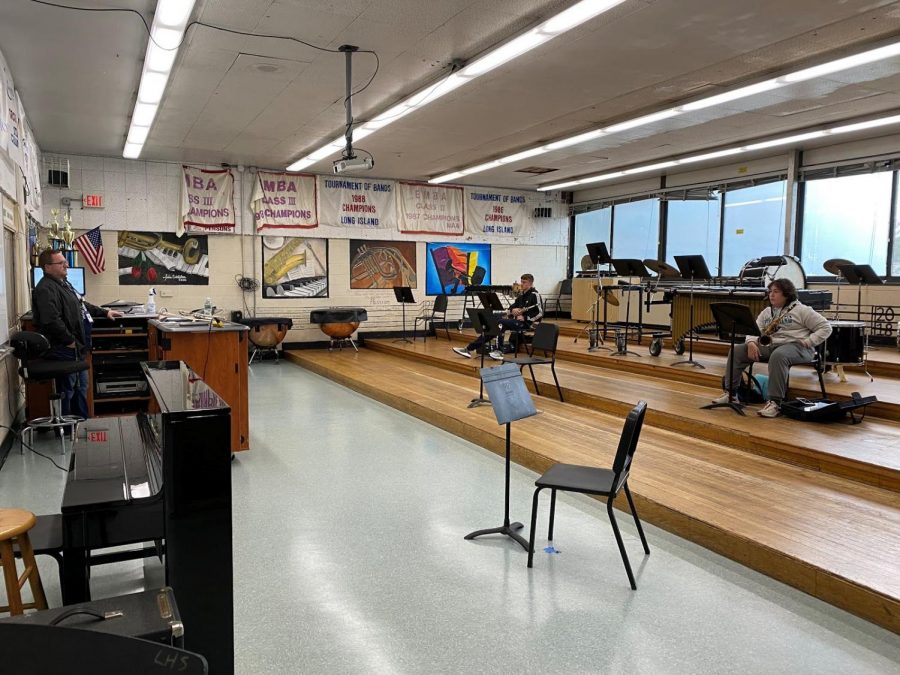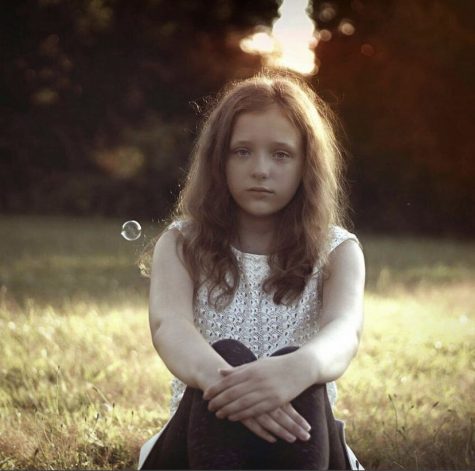Musical Classes During Hybrid Learning
November 3, 2020
With Lindenhurst High School currently at 25% capacity, The Charles Street Times takes a closer look into the variety of music programs that are offered such as band, chorus, orchestra, and theater arts, to showcase what each program is doing in order to keep up with the online learning environment.
Choir
Mr. Pram, the choir director at Lindenhurst High School gives an insight into what he plans to do with the program during these unprecedented times. “I’m kind of operating on the assumption that we will be back to normal again someday and I don’t want my students to lose the skill of singing where you have to hold your part to another part so I haven’t changed a lot.” Mr. Pram also states that the singers of Lindenhurst would have to opt to sing more individually than they have ever had to do before. “I’ve changed instead of working on pure choral works, we are exploring the musical Hamilton so there is a lot of solo stuff in there so in terms of choral singing it makes it easier.” This transition to have more individuality has led to a difficulty of unity in sound which leads Mr. Pram to trust the process and hope that in the end, it will all sound great. “We won’t know for sure unless we are all together to see the finished product.”
During performances, if this capacity should continue throughout the year, Mr. Pram has decided to use technology and software he has never had to use before. “You have to use what’s called Click Tracks where everybody would record themselves singing to a single track and then you take the finished product and you have to line up all the sound together and then blend it”.
Compared to the already difficult job of having to harmonize and blend with other singers (which is very difficult even for professionals) having to do so without hearing the whole product would result in extreme difficulty. However Mr. Pram gives young singers and vocalists of Lindenhurst some advice that may come in handy. “I think the best thing to do is, like in any class, if you are struggling in a subject you want to find someone that is really good at it and kind of work with them or next to them and try to pick their brain and how they do it. Standing with someone who is s good singer and rub off on you and make you a better singer”
Band
The band this year is also in a very similar predicament compared to the other arts programs. Band requires unity and that can be very difficult to achieve when not being able to come together and perform. Mr. Pike, a band teacher at the Lindenhurst High school states, “We are doing something called Flex music…that will work with all varying degrees of instrumentation. Some classes it works better than in other classes.”
Mr. Pike, also explains how lessons are operating during this time “75% of the students are doing lesions remotely in small groups of one to three students, mostly in the same instrument groups and students who are able to work out their schedules with me, I teach them in person.”
Mr. Pike described how a significant challenge is having to change your expectations on what you will hear and what kind of music you can use. If such, learning will continue online then Mr. Pike will be doing a similar thing as Mr. Pram with recording individual groups and putting them together using new technology. He predicts, “Virtual performances where I record the students in their small groups and classes, and then we could post those up on a website, as long as we get the rights to the music…There would not be live full in person concerts though.”
Mr. Pike, and many other music directors, would much prefer to have the capacity go up to even 50% so that it would significantly help the band and each of its members
Orchestra
String and Symphony Orchestra are two different levels of Orchestra. String Orchestra is for freshmen and sophomores, while Symphony Orchestra is an advanced version of String Orchestra.
Normally, in a standard day, a regular orchestra session is a class period in length. This now contains a self-done tuning session. In high school the skill of tuning your own instrument becomes self-made and self evident.
Mrs. Lombardo, the teacher of both classes, requires the students to independently learn a scale ranging from four selections (we already know) to moderately easy scales in different positions. In addition, students learn a piece called the Two Octave Chromatic Scale. Mrs. Lombardo describes it as, “The chromatic scale uses all 12 tones (or pitches) in the tonal system, where a typical “major” or “minor” scale uses seven different pitches. Practicing a chromatic scale helps a string player to better understand the geography of the fingerboard and the enharmonic relationships that exist amongst the pitches.” Unfortunately most students in String Orchestra had trouble with this piece and had to do it again.
The last assignment in Orchestra is a NYSSMA solo from levels three to six, three being the easiest and six being the most difficult. The recommended level is anything lower than six depending on your skill and pride. Mrs. Lombardo was a bit against the String Orchestra kids accomplishing a level six piece. The goal is trying to learn a quarter or half of the piece every marking period. If you learn more than a quarter then you have to do another solo afterwards. The goal of working in this format is to strengthen the students individual skills by selected a piece from a Google Drive folder sent by Mrs. Lombardo. String and Symphony Orchestra have the same assignments just on a different level of difficulty.
If you are interested in learning the bass please come on down to Room 165, as there are no basses in String Orchestra and Mrs. Lombardo is happy to accept and teach anybody interested.
Theatre Arts
Theater Arts is much different, according to Carissa Covais and Liz Ryan, two freshmen here at LHS. Most of the work is improv combined with a bit of written work. One example is what is called an inch scene. To summarize an inch scene is pint-sized section of lines for two people to act to their fullest ability.
This may sound normal for a drama class; however, in class there are sometimes only three or four kids able to perform. On the other hand, the students not present in class have to record. It is required to act with a partner; however, the students have very little choice in that aspect. Liz Ryan, another freshman feels, “We don’t have the luxury of having class everyday to rehearse. We only have time to rehearse in person every four days. And that’s not even considering the fully remote students. When we perform, it’s for our peers on a google meet. The fact that we don’t have a physical audience present affects the performances a bit.” Carissa agrees, “For me at 25%, I only have two other kids in my class and one of them usually misses a lot. So I only get one choice of a partner most of the time and I’m not really friends with them so it is difficult to get in contact with them.”
Nonetheless the Fine Arts classes had to adapt and work through the drastic changes at the moment. Although their plans may seem rough around the edges, there is always room and time for improvement.



